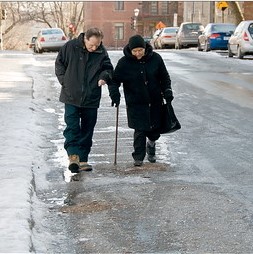Health Talk: Avoid Winter Falls
Each year, 2.8 million older adults are treated for fall-related injuries. Over 800,000 of those people require hospitalization. Most of them have head or hip injuries. The chances of suffering from a fall in colder weather increase after 65. After age 75, 2.8 million Americans are treated for falls.
Understanding contributing factors and prevention tips will help reduce fall risk in snowy/icy conditions.
Factors Contributing to Falls
- Lack of foot sensation
As we age, the sensation in our feet can decline from conditions like diabetes, peripheral neuropathy, arthritis, vertigo, lingering effects from a stroke and other reasons. The lack of sensation can be prominent or slight – one moment the feeling is gone but returns a moment later. Sensation in the feet helps us to determine if we’re walking on soft (e.g. carpet) or hard surfaces (e.g. pavement). Even with shoes on, feet can help us determine if surfaces are icy. In those situations, we tend to walk more cautiously. Without sensation, falls are more likely to occur because it’s difficult to determine if a surface is icy. - Reduced visibility
Black ice is already difficult to detect but combine that poor lighting or with a condition like low vision and the chance of not detecting ice and falling becomes greater. - Reduced cognition
Some medications (e.g. Tramadol, Meclizine and others) can cause dizziness and drowsiness, which can affect detecting and responding to ice. Similarly, feeling tired can increase accidental slips and falls to occur. Not only is cognition affected but feeling tired also causes the muscles to feel tired. - Unsteady gait
Age can oftentimes result in a lack of balance and walking to be unsteady. Many people use rollators, canes and walking sticks as a result. When walking on ice, that unsteadiness can increase the risk of falling as it’s harder to quickly stabilize from a slip on the ice, especially without an aided walking device.
Fall Prevention Tips
- Reduce back and knee vulnerability
Avoid standing and turning the body in ways that feel awkward and add strain. For example, standing straight with legs close together while turning the back feels more natural and comfortable than taking a wide stance and turning the back. - Maintain a stable posture
Tightening the core and slightly bending the knees can help stabilize a slight slip on the ice. - Keep the hands free
When carrying items in the hands, the typical first instinct is to hold on to those items when slipping and falling. If there is nothing in the hands, they are free to help stabilize the body from a serious fall and injury. - Choose heavily traveled paths
Heavily traveled paths tend to be less icy than paths than those that have not experienced much foot traffic. More wear and tear breaks up more of the snow and ice. There’s also a greater probability that those paths have been treated. Though sometimes those paths may not be offer the shortest distance, they will be safer. - Plan ahead
Refraining from walking in the snow and ice is the best way to prevent a winter-weather fall. In cases when that’s not feasible, wear footwear that has a rough tread like snow boots. Sneakers are often thought to be good in snow and ice, but they are not meant for snow and ice so the tread is not as significant as snow boots. Certainly, avoid heels and open toe and heel shoes and shoes with little to no tread. - Use a vehicle door cane
Getting in and out of vehicles tend to be more challenging with age and more so in snowy/icy weather. Vehicle doors are heavy and can be very unstable, especially in windy conditions. The body also tends to be in an awkward position when getting in and out of a vehicle. Combine both with snow and ice, the chance of falling increases. A vehicle door cane, a handle-like device that slips into a vehicle door lock when the door is open, can help provide stability.
Fall risk in snowy/icy weather increases with age especially when factors like lack of foot sensation, visibility, cognition and balance are present. However, certain precautions can help reduce the chance of falling and being seriously injured. Though the best precaution is to avoid walking in the snow and ice. After all, wouldn’t you rather stay home where it’s warm and cozy? It’s cold out there. Brrr.
Learn about our Rehabilitation services including outpatient services for Howard County residents who have Medicare as their primary insurance.
About the Author
Sheetal Patel is the director of rehabilitation at the Lutheran Village at Miller’s Grant. She has a master’s degree in physical therapy with specialized training in manual therapy from Australia and has over 20 years of experience in orthopedics and geriatrics.

